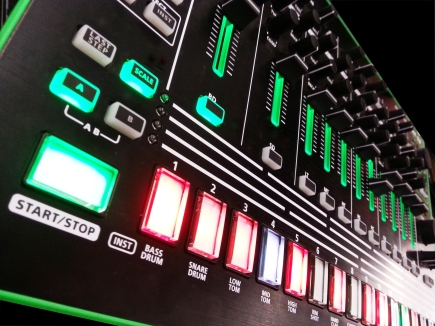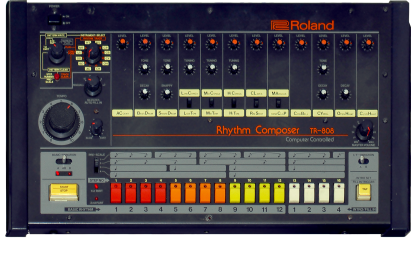In Depth With Roland Aira
Roland as a company, has had a huge impact on shaping the sound palate of both early and modern music including;
Hip Hop, Pop, House, Techno and Soul to name a few.
Introducing the Aira range and ACB Technology
Analog Circuit Behavior is Roland’s own approach on component modeling and the relationship between components and how they interact to create subtle differences in tonality and warmth with every note produced. This technology is state of the art in emulating analog and has gotten to the point where some would argue that they can not tell the difference between real analog units and digital units with A.C.B. It is safe to say that there are some serious discussions on whether digital modeling can achieve the depth of sound created by real analog components. That being said, I was quite impressed with all the units, specifically with the sound quality of the TR-8.
Introducing the TR-8
If we think in terms of drum machines the TR-808 (1980) and the TR-909 (1983), are some of the most recognizable drum sounds in modern music. The TR-808 is featured in more hit records than any other drum machine ever built. From Marvin Gaye and Phil Collins to Kanye West, Aphex Twin, Dr.Dre, Outkast and the Prodigy amongst other artists. Although the TR-808 has become so incredibly popular, very few individuals have actually had a chance to own a unit as production on the drum machine was discontinued in 1984 as sampling technology had started to take preference. As purists would argue a sample based drum machine will always output the same sample with an identical tonality each time, as opposed to an analogue drum machine which produces each note individually through it’s components.
With a global obsession of the 808 and 909, as well as the astronomical prices of analog equipment – it is very difficult to get your hands on. (Although the 909 is partly analog). With this massive resurgence, Roland has decided to release a new digital hybrid of the 808 and 909 that has their focus placed on recreating how these analog components interact with each other to give each drum hit it’s own unique character, analog circuit behavior.
Performance and Functionality
Upon looking at the new TR-8, there are many similarities in it’s design layout. Such as it’s quintessential 16 button step sequencer that has been transformed into a brilliant multi coloured RGB layout. As well as all the various drum sounds and their attribute knobs including some extra parameters such as Tune, Compression and Attack for sculpting the sound even further. Keeping the classic feel of the 808 and 909 series was of extreme importance to Roland but with some added new features and functionality to push the unit into the modern age of music technology. These new additions include built in Reverb and Delay effects that can be sequenced and assigned to specific sound sources. There are 8 different types of delays and reverbs available to choose from using the Instrument button. Another new feature is the Scatter function jog wheel which acts like a real-time beat repeat or stutter effect. It has 10 different intensity parameter settings which effects your playing sequence and is used as a performance tool.
The TR-8 can be sequenced in the traditional way or played and recorded in real-time using the Instant Record or Instant Play buttons. A new design improvement is the mixer style volume faders for each sound source which makes it easier to balance your drum mix live. Seeing as the TR-8 is a hybrid of the 808 and 909, each sound source can be exchanged between the two kits using the Instrument button. The Kit button allows you to choose from 16 different kit combinations that you are able to edit and adjust while your drum sequence is playing. The Pattern Select button shows you 16 different drum patterns that you are able to edit and by holding down one pattern button and pressing another, you are able to extend your 1 bar pattern up to a 16 bar drum sequence. You are also able to copy and paste patterns by holding the Pattern Select button, then pressing the pattern you want to copy, by selecting a pattern bank where you want to paste your duplicate in. Unfortunately the TR-8 needs to be stopped for you it to perform this function, which I trust will be fixed in a firmware update.
Inputs and Outputs
At the back of the TR-8, the unit has a regular phones out, a stereo mix out and stereo assignable output. An external stereo input is available to enable side chaining functionality through the unit. This will make use of the External In level and Side Chain knobs with the ability to sequence a side chaining pattern. This side chaining pattern would effect the external sound input by ducking the audio where sequence markers are placed, generally used with the Roland TB-3 or System-1. There are 8 different types of side chain compression available when pressing the Instrument button when the External In is selected.
In addition a MIDI in and MIDI out port is available that allows the unit to send and receive MIDI messages as well as clock sync. The TR-8 can not record automation in the unit but can be remote controlled using MIDI CC messages from your DAW. Ableton users can use a Max4Live device created by Nerk to remote control the unit to enable automation recording (see link below).
A USB port enables the TR-8 to be connected to a computer and acts as an external audio interface with the use of a DAW. This will allow track separation with 14 mono outputs or 7 stereo outputs for in depth control of channels for adding external effects or additional audio processing. This makes it easier to record audio separates in studio for those that might not have access to 14 inputs on their audio interface. This might be cumbersome for those that want to use the TR-8 without a DAW in a live situation with a mixer. The TR-8 as an external audio interface, has a fixed sample rate of 96000 which ensures its superior audio quality, however it would be preferable to have the option to adjust the sample rate for flexibility.
In My Opinion
The Analog Circuit behavior sounds great, and the sample rates of all the Aira units ensures superior sound quality. There were some issues transmitting so many audio channels simultaneously via USB (popping and crackling) while using a 512 buffer size whilst using my UA Apollo Quad.
Not being able to copy and paste a pattern whilst a sequence is playing is quite unfortunate. You can implement velocity sequencing by starting up the unit whilst holding PTN Select and pressing the TR Rec button to light up, which is an important added feature, specifically for sequencing hi-hats. I would’ve liked to see automation recording on the device seeing as it is a digital unit, however this can worked around by using Max4Live and MIDI CC messages.
The Legacy of the System-1 Synthesizer
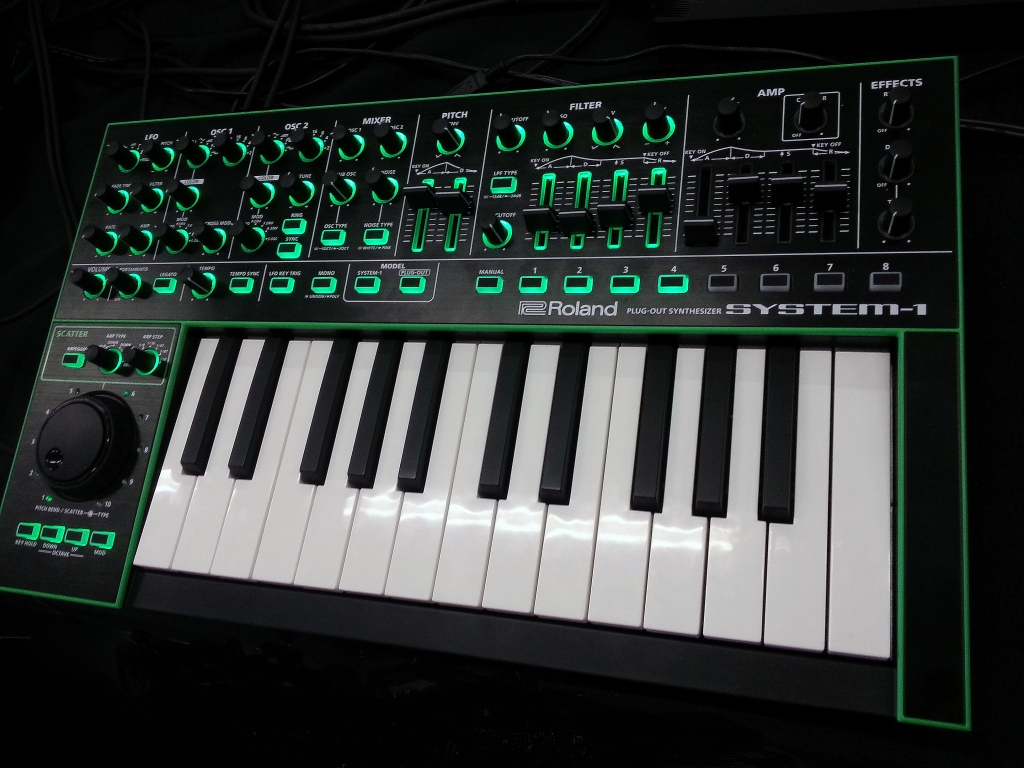
As some of you might know the new System-1 synth in the new Roland Aira line is based off of the classic 1970’s semi-modular System 100 and System 700 synthesizers. These units have built up quite a reputation with synth connoisseurs and musicians, because of it’s versatility of use and distinct sonic characteristics. Amongst these artists are the likes of Depeche Mode, Mute Records label head Daniel Miller, the Human League and Vince Clark (early Depeche Mode and Erasure). As these synths became branded as classics and production of them ceased (System 100 1975-1979, System 700 1976-1982) they became highly sought after by collectors and musicians alike.
Roland have constantly been at the forefront of what musicians are searching for and have decided to reincarnate the spirit and the essence of these legendary ghosts. This amalgamation took on the form of the System-1, a modern compact unit that is both dynamic, affordable and versatile.
Sonic Exploration with the System-1
Having my first glance at the System-1 made me rub my hands in delight as I looked at the total of 72 parameter buttons, faders and knobs that I could use to sculpt my sounds. The synth design has two oscillators, one sub-oscillator, one noise oscillator, one LFO, an oscillator mixer section, a pitch envelope AD, a Filter envelope ADSR, an Amp envelope ADSR and a built in Delay and Reverb effects section. It has four voices that allow polyphony for chordal work and can easily be transformed into a monophonic lead by pressing the Mono button. Unison functionality is available when pressing the Mono button again (flashing), for very strong lead sounds.
The Oscillators
The two oscillators have six different wave shapes to choose from. The three classic shapes; triangle, square and sawtooth are available. As well as new super wave shapes; super sawtooth, super square and super triangle that essentially is several duplicates of the selected wave shape slightly out of phase, to create very strong sounds with loads of presents and character. The two oscillators have slightly different parameters – you can use the Cross Modulation parameter on Osc 1 to apply modulation from Osc 2, this rendered some very rich sonic results. The ability to change the tuning of Osc 2 is available to add more depth and intricacy when blending the two wave shapes, as well as the added Ring Modulation and Sync buttons to achieve very metallic sonic textures. Both oscillators have a Modulation knob with which you assign one of six parameters that you want to apply modulation to. The choices of parameters are Main, LFO, Pitch Envelope, Filter Envelope, Attack Envelope and Sub Oscillator. Once the respective parameter is selected the use of the Color knob will apply the amount of modulation you specify.
The LFO
The LFO design is quite simple. There are the standard six wave shapes to choose from; Sine, Triangle, Sawtooth, Square, S&H and Random. A Pitch knob is available to add modulation to the pitch via the LFO. The Fade Time parameter lets you assign an attack time for the LFO to kick in. The Filter parameter allows the LFO to effect the opening and the closing of the filter. The Amp parameter allows the amplitude to be effected by the LFO and the Rate (quite self explanatory) allows you to change the rate of the LFO, which can be free or in sync by pressing the Tempo Sync button.
The Mixer
The mixer section has Osc 1 and Osc 2 gain levels as well as your Sub Osc gain and oscillator type button (10CT = LED lit, 20CT = LED off). As well as a Noise gain knob and type button (White = LED lit, Pink = LED off).
The Pitch Envelope
Two sliders are available to change the Attack and Decay time of your pitch envelope as well as a Env shape knob to specify the modulation movement.
The Filter Envelope
The filter envelope has attack, decay, sustain and release faders, a Low Pass Filter Cutoff knob. When pressing LPF Type you are able to change between -12db or -24db filter. A great addition is a separate High Pass Filter knob which allows the ability to remove any rumbling low-end in the sound sculpture. The standard Resonance knob is available as well as a Env shape knob. Lastly a Key knob is added to allow specific allocation of whether the filter cutoff opens or closes depending on where you play on the keyboard.Because of the 96000 sample rate the filters have absolutely no stepping and sounds really smooth. Due to it being a digital filter, the resonance can spike quite intensely.
The Amp Envelope
The standard attack, decay, sustain and release faders are present to allow maximum control over the amplitude. Turning up the Tone knob adds brightness to the the sound and turning it down creates body. To add a lot of modern digital characteristics, a Crusher knob is available to bit crush your sound into oblivion.
Built in Effects
The System-1 has a built in Reverb knob to add spacial dimension to your sonic texture, this can transform a flat sound into something a bit more lush. I would’ve loved to see a reverb type selector or a cutoff knob as the low frequencies get picked up quite heavily by the reverb. The added delay is quite basic but has the ability to be in sync, with the use of the Tempo Sync button. The built in delay effect emulates an analog delay line which re-pitching functionality.
Plug-out and Virtual Synthesizers
Roland has quite cleverly developed a Plug-out function which allows the System-1 to download Roland modeled virtual synths such as the SH-101 into the unit itself. This will allow the use of that VST inside the System-1 to be used without a computer. The back-lit parameter indicators will display which attributes will be available for use from that particular VST on the unit. Roland has indicated that there will be a number of vintage VST synthesizers available soon, starting with the infamous SH-101. Once the VST is loaded the option of switching between the native System-1 mode and the Plug-out virtual synth mode will be available with the press of the respective model button.
Arpeggio and Scatter Mode
By looking at the Arpeggio section on the System-1, it could easily be mistaken that it’s functionality is standard. While on the surface it performs like a usual arpeggiator, with Arp Type and Arp Step selectors. The rotary jog wheel allows you to select various types of arpeggio patterns to create further syncopated arp/chordal patterns. On top of that the arpeggio functions are incorporated with the new Scatter effect housed by the entire Roland Aira range. Scatter allows the respective unit to rephrase what is being played, very similar to Ableton’s Beat Repeat or iZotope’s Stutter Edit. On the System-1 the Scatter function is built into the pitch bend dial and changes the response of the arpeggio pattern playing. By using the rotary encoder you can select from ten various scatter modes. Every Scatter mode has a different function that use various parameter combinations and is enabled when the Pitch/Scatter dial is turned. When Scatter mode is active the back lit LEDs of the parameters in use, flash to inform the user. For example, when Scatter mode 1 is implemented, the unit indicates the Low Pass Filter, High Pass Filter and the Cross Modulation is used for the particular effect. The arpeggiator also respond differently by doubling up the selected arpeggio note value when turning the dial clockwise (8th notes become 16ths) or halving the note value when turned counterclockwise (8ths to quarter notes)
Inputs and Outputs
As with all the other units in the Roland Aira line, the System-1 has a USB input to allow the synthesizer to be used as a external audio device on your DAW of choice. When connected to your computer via USB you will be able to sync an external clock as well as send and receive MIDI messages and have separate audio channels available. However I wasn’t able to find the drivers on the Roland website as the unit has just been released, which was quite frustrating. Standard MIDI in and out ports are available to enable sync with other Aira devices without a computer. Two pedal inputs; Control and Hold are also available to add expression and sustain, along with a phones out and stereo output.
In My Opinion
The System-1 is not a modular synth despite the name and the reference to the System-100 and System-700 which are both semi modular analog synthesizers. The unit was quite difficult to get a warm tone out of, as most of the sounds it generates are brittle and sharp sounding because of it’s digital filter with very spiky resonance. I was however pretty impressed with how versatile the two oscillators were in terms of the Cross Modulation, the sound coloring and the super wave shapes. This synth is more geared toward glitch based lead sounds and hard digital arpeggio sounds.
Unveiling the TB-3
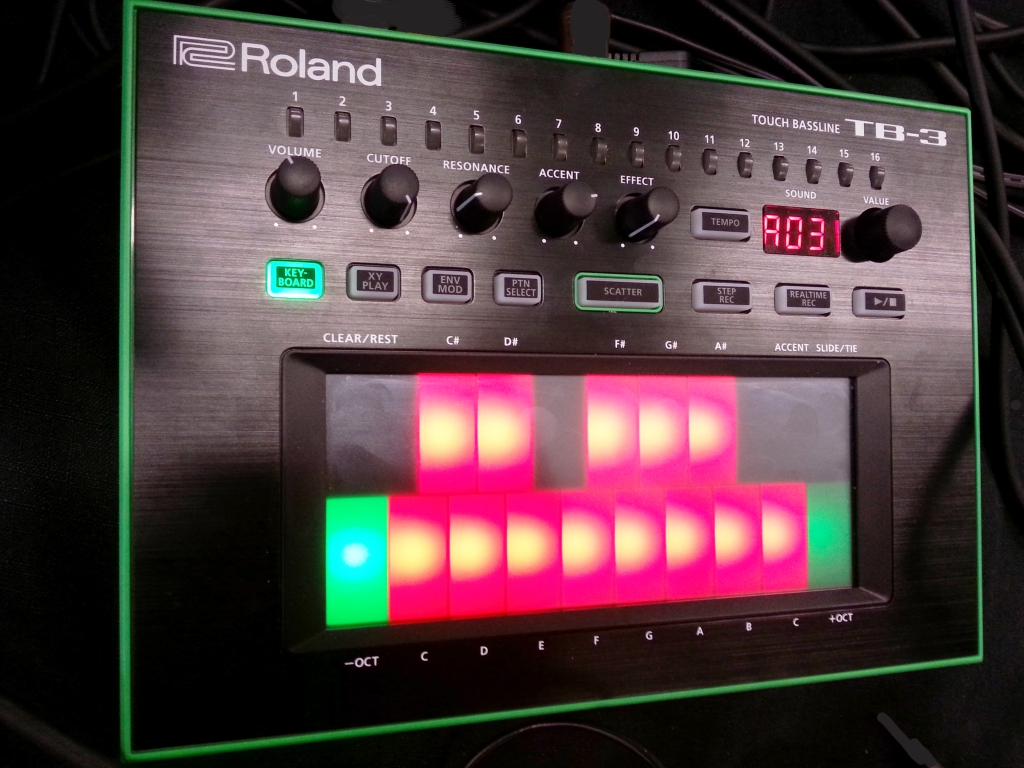
The Ironic History of the 303
The Roland TB-303 bass sequencer along with the TR-808 have single-handedly shaped the face of dance music around the world. Like a glove fits perfectly on a hand, the two are practically inseparable. The ironic history of the 303 is that it was designed to accompany keyboardists and guitarists to emulate a real bass player. The unit however did not sound anything like a real bass and failed to sell when it was released in 1982 and then soon discontinued in 1984. Shortly after the unit was taken off the shelves, a sonic revolution emerged with the 303 at the centre of this new musical movement. The 303 dubbed the “Acid House” music style, entailing a short repetitive bass sequence on the 303 that has a modulating filter movement to create the quintessential squelch (sharp) resonant tones. The 303 was widely used by artists such as The Prodigy, 80’s punk band Orange Juice, Josh Wink and Fat Boy Slim amongst loads of others.
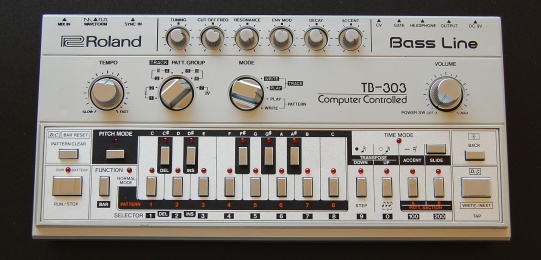
The New Face of the 303, Introducing the TB-3
The look of the TB-3 interface is is quite different as the unit is predominantly a touch pad with the standard; Volume, Filter cutoff, Resonance and Attack knobs available. There are sixteen green LED lights to indicate the step being played or selected. Quite a few new features are added to the device such as an Effect knob that changes its attributes depending on the selected patch, from delay to distortion. A Value dial to select presets or steps depending on the page button selected. The new Aira Scatter effect button is used to glitch up your sequence. There is also a numeric tempo display to give you visual feedback of the current tempo.
Use and Functionality
The TB-3 has four different playing modes built into the device. Keyboard mode; to play notes in real time, Step Rec; to sequence notes in steps, XY Play mode; used to slide your finger on the touchpad to achieve a theremin lead type sound and the Realtime Rec mode; to record notes played in realtime, that are automatically quantized. When pressing the Step Rec the TB-3 is approached in the traditional sequencing method. The sixteen step LEDs indicate which step is being edited and the Value knob is used to scroll between steps. Automatically a new sequence will have sixteen steps but when holding the Step Rec and turning the Value knob you are able to select up to thirty two steps per pattern. The touch display indicates the note selection and the Slide and Accent buttons in green give you the ability to shape the phrasing of your sequence. You are able to apply shuffle to your pattern by holding down the Tempo knob and turning the Value knob clockwise or anti clockwise.
Once you have completed your sequence you are able to change the sonic characteristics of the pattern by pressing Env Mod. The touchscreen now switches into a XY modulation/decay touch interface that has aftertouch capabilities. Unfortunately I was not able to get a lot of staccato expression out of the envelope modulation page and there is no decay knob to be found, which was quite disappointing. By pressing the Ptn Select button, you are able to copy and paste patterns and extend the number of patterns to be played in your sequence by simply pressing on your first selection and sliding your finger to the right. This allows for some intricacy of use in conjunction with each pattern having its own amount of active steps.
Inputs and Outputs
The TB-3 comes equipped with a 1/4 inch jack stereo output, a output for headphones and a USB to connect to your computer as a external audio device that will send audio and send and receive MIDI messages. The traditional MIDI in and out ports are also available to send or receive MIDI clock and MIDI CC information.
In my Opinion
I had quite a bit of fun with the device sequencing in patterns predominantly, because of the difficulty in playing the TB-3 touchpad with accuracy, as the Realtime Rec mode quantizes your playing whether you like it or not, even when sliding from one note to the next. The touch screen is not capable of multiple touches and gets confused when receiving two input values simultaneously. There is no decay knob which limits the amount of control of the device. The filters sound great and the ACB technology sounds believably analog. USB integration is a big plus to conveniently connect to your DAW.
Getting to know the VT-3 Vocal Transformer
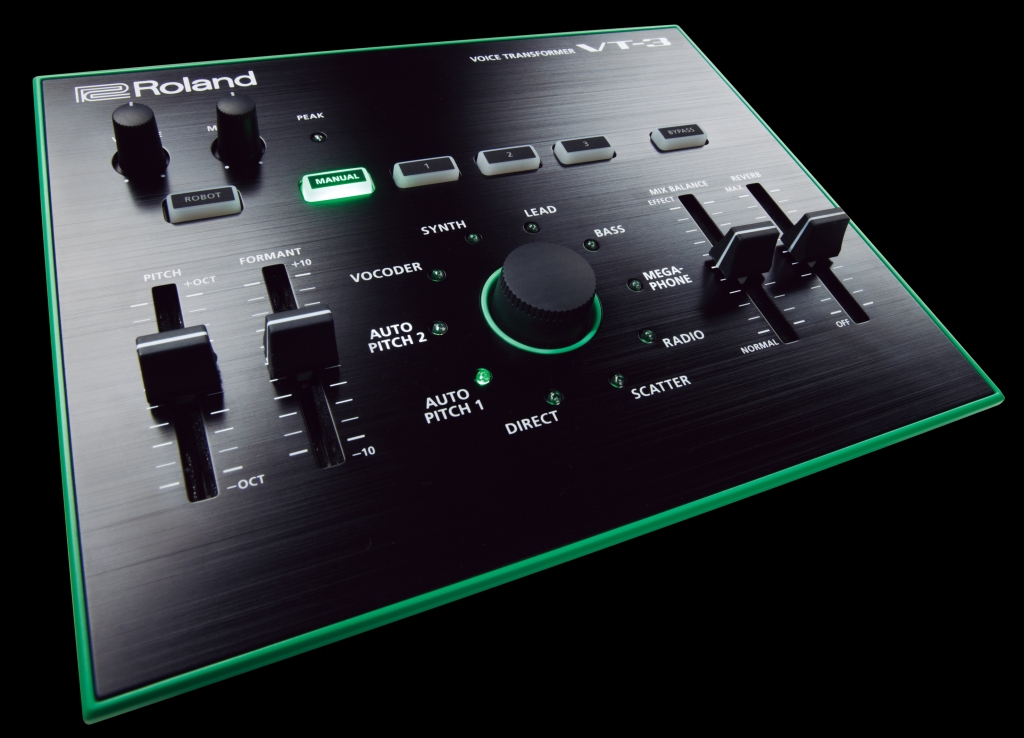
The new Roland VT-3 is based off of the 1970’s VP-330, a ten band vocoder that is one of the units that immortalized the classic robot voice. The VP-330 was deemed as one of the best sounding vocoders ever developed and was equipped with certain unique features such a vocal strings effect.
Exploring the VT-3
Having a look at the VT-3, it has a total of 9 effects; Auto Pitch 1 and 2 – for vocal harmonies, Vocoder – for the classic 1970’s vocoder voice, Synth – more of a masked voice effect that resembles a chordal synth patch rather than a voice (hence the name), Lead, Bass – quite a dub step ‘wobble’ flavor to the effect, Megaphone, Radio and the new Scatter effect featured in all the Aira units, which stutters the incoming audio signal. There are 4 parameter faders available; Pitch – ability to create vocal harmonies up to one octave higher or lower, the Formant – to change the vocal timbre, Mix Balance – a dry/wet fader for the amount of the effect and the Reverb fader for additional reverb to the desired vocal effect. Mono-tonal voice effects can also be applied by pressing the Robot button in conjunction with the selected effect.
Inputs and Outputs
The VT-3 has a universal balanced input that receives both a 1/4 inch jack or a XLR mic cable and phantom power that allows the use of dynamic microphones. A expression pedal port is available for additional modulation control. A stereo mix output is available, but the VT-3 can be run in mono as well by the flick of the Bypass switch. Lastly, like all the other Roland Aria units, a USB port is available for connection to a computer as an external audio interface on any DAW.
In My Opinion
When I was asked to review the Roland Aira VT-3 amongst the other units I asked a good friend of mine and a seasoned vocalist, Tebogo Moloto, to explore the device with me. We soon came to the conclusion that it is not an effects unit to sing through but it got better results doing more vocal percussion and syncopated rhythms through it. Finding a musical use for the VT-3 was exceedingly difficult, it unfortunately felt like a gimmicky toy designed for very short-lived amusement.
Conclusions and Understandings
I had two weeks of getting to know the complete range of Roland’s new Aira series and I have spent every minute accumulating knowledge and opinions from as many different sources as humanly possible. My ultimate conclusion is that Roland has given the immediate market what they wanted and have ultimately created a successful range of fairly cheap units that sound good. The audio quality of all the devices is truly second to none, again the ACB technology does make a huge difference as well as the 96K sample rate. The downfall however comes into the functionality of some of the units, for example not being able to copy and paste a pattern as the TR-8 is playing. Not being able to record note slides on the TB-3 without it being chopped up and quantized, or the lack of articulation control without a release knob on the TB-3. The good news is that these units are digital and there is a possibility that some of these issues can be addressed with firmware updates (especially the release knob on the TB-3, just kidding).
For the price these units are going for I can understand its place in the market and it is great to see such a interest and resurgence in outboard gear. This will allow the younger individuals that haven’t owned actual real outboard gear to build up a personal relationship with their hardware instead of ending up downloading more VST’s and dumping them a few days later. I personally found myself bonding with some of the units more than others, but there was a connection developed and that is the whole point of using an instrument, whether it is digital, acoustic or analog.
These units will definitely have an impact on the industry. Good. Bad. You decide.
Resources
http://www.maxforlive.com/library/device/2247/roland-aira-tr-8-drum-rack-and-remote
http://www.maxforlive.com/library/device/2246/roland-aira-tb-3-remote

